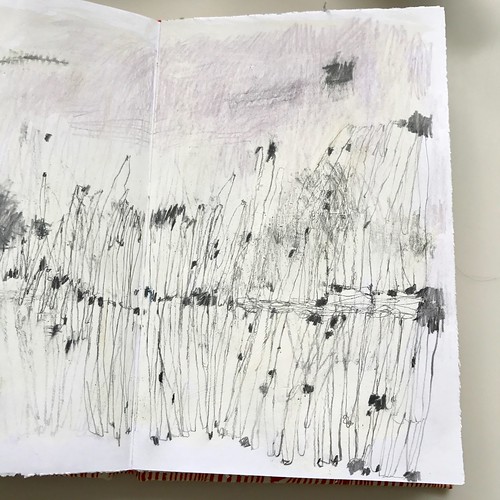Cysteine ligase (GCL) and heme oxidase-1 (HO-1). Western blotting analysis shows that ACS84 treatment for 4 h promoted the nuclear translocation of Nrf-2 from cytosol to nuclear (Fig. 4A).Protective Effect of ACS84 a PD ModelTable 1. Effect of ACS84 on dopamine and its metabolites in 6-OHDA-lesioned striatum.Treatment Sham Vehicle ACSDopamine 8.2561.01 1.6160.45# 7.3561.62*DOPAC 2.5460.71 1.0060.24 3.8160.89*HVA 1.4760.23 0.7160.10 2.1560.41*Dopamine/DOPAC 4.9060.74 2.0360.72# 2.1560.Dopamine/HVA 5.9660.46 2.2460.50# 4.9060.67*The concentration of dopamine and its metabolites in 6-OHDA-lesioned striatum were measured using HPLC. Units for Dopamine, DOPAC and HVA 12926553 concentrations were ng/g tissue. Data are presented as mean 6 SEM, n = 6?. # p,0.05 versus Sham group and *p,0.05 versus Vehicle group. doi:10.1371/journal.pone.0060200.tGlutamate cysteine ligase catalytic subunit (GclC), Glutamate cysteine ligase modifier subunit (GclM) and HO-1 are three important Nrf-2 target genes. RT-PCR also showed that the mRNA levels of these three genes were significantly elevated after treatment with ACS84 for 4 h (Fig. 4B). These data suggested that ACS84 SPDP Crosslinker site induced Nrf-2 nuclear translocation and promoted the expression of anti-oxidant enzymes, which contributed to the protection against 6-OHDA-induced oxidative stress.striatum. From the immunostaining results (Fig. 6), unilateral 6OHDA lesion destroyed most of the tyrosine hydroxylase positive (TH+) neurons in SN pars compacta in the injured hemisphere, while the administration of ACS84 remarkably attenuated the effects. As tyrosine hydroxylase is the rate-limiting enzyme in dopamine synthesis, this data suggests that ACS84 may preserve the function of dopaminergic neurons in 6-OHDA-injured.ACS84 Ameliorated Behaviour Symptom in the Unilateral 6-OHDA Rat ModelTo evaluate the therapeutic effect of ACS84 on Parkinson’s disease, we established the unilateral 6-OHDA lesion rat model. Four weeks after 6-OHDA lesion, the PD rats were injected intragastrically with vehicle or ACS84 (10 mg/kg) 23727046 daily and the treatment continued for 3 weeks. As shown in Fig. 5, ACS84 significantly ameliorated the rotation behaviour after 2 weeks of treatment, which indicated that the administration of ACS84 may alleviate the behaviour disorder in Parkinson’s disease.ACS84 Relieved the  Declined Dopamine Level in the 6OHDA-injured StriatumWe further examined the dopamine and its metabolic products levels in the injured striatum. The concentrations of dopamine and the dopamine metabolites, dihydroxyphenylacetic acid (DOPAC) and homovanillic acid (HVA) were measured with HPLC. As shown in Table 1, 6-OHDA lesion significantly decreased the concentrations of dopamine, DOPAC and HVA in the injured striatum, while ACS84 treatment reversed these effects. These data were comparable with the results of behaviour test and immunofluorescence staining, indicating that ACS84 efficiently alleviated the loss of dopaminergic neurons and the deficient of dopamine in the striatum. In our experiments, we observed a significant increase of dopamine/HVA ratio but not dopamine/ DOPAC ratio in ACS84 Salmon calcitonin price animals compared with vehicle group,ACS84 Attenuated the Degeneration of Dopaminergic Neuronal in SNThe movement dysfunction of the PD model is mainly associated with the loss of dopaminergic neurons in the SN andFigure 7. Effect of ACS84 on oxidative stress in the striatum of unilateral 6-OHDA-lesioned PD rat model. ACS84 treatment (10 mg kg21 day21, i.g).Cysteine ligase (GCL) and heme oxidase-1 (HO-1). Western blotting analysis shows that ACS84 treatment for 4 h promoted the nuclear translocation of Nrf-2 from cytosol to nuclear (Fig. 4A).Protective Effect of ACS84 a PD ModelTable 1. Effect of ACS84 on dopamine and its metabolites in 6-OHDA-lesioned striatum.Treatment Sham Vehicle ACSDopamine 8.2561.01 1.6160.45# 7.3561.62*DOPAC 2.5460.71 1.0060.24 3.8160.89*HVA 1.4760.23 0.7160.10 2.1560.41*Dopamine/DOPAC 4.9060.74 2.0360.72# 2.1560.Dopamine/HVA 5.9660.46 2.2460.50# 4.9060.67*The concentration of dopamine and its metabolites in 6-OHDA-lesioned striatum were measured using HPLC. Units for Dopamine, DOPAC and HVA 12926553 concentrations were ng/g tissue. Data are presented as mean 6 SEM, n = 6?. # p,0.05 versus Sham group and *p,0.05 versus Vehicle group. doi:10.1371/journal.pone.0060200.tGlutamate cysteine ligase catalytic subunit (GclC), Glutamate cysteine ligase modifier subunit (GclM) and HO-1 are three important Nrf-2 target genes. RT-PCR also showed that the mRNA levels of these three genes were significantly elevated after treatment with ACS84 for 4 h (Fig. 4B). These data suggested that ACS84 induced Nrf-2 nuclear translocation and promoted the expression of anti-oxidant enzymes, which contributed to the protection against 6-OHDA-induced oxidative stress.striatum. From the immunostaining
Declined Dopamine Level in the 6OHDA-injured StriatumWe further examined the dopamine and its metabolic products levels in the injured striatum. The concentrations of dopamine and the dopamine metabolites, dihydroxyphenylacetic acid (DOPAC) and homovanillic acid (HVA) were measured with HPLC. As shown in Table 1, 6-OHDA lesion significantly decreased the concentrations of dopamine, DOPAC and HVA in the injured striatum, while ACS84 treatment reversed these effects. These data were comparable with the results of behaviour test and immunofluorescence staining, indicating that ACS84 efficiently alleviated the loss of dopaminergic neurons and the deficient of dopamine in the striatum. In our experiments, we observed a significant increase of dopamine/HVA ratio but not dopamine/ DOPAC ratio in ACS84 Salmon calcitonin price animals compared with vehicle group,ACS84 Attenuated the Degeneration of Dopaminergic Neuronal in SNThe movement dysfunction of the PD model is mainly associated with the loss of dopaminergic neurons in the SN andFigure 7. Effect of ACS84 on oxidative stress in the striatum of unilateral 6-OHDA-lesioned PD rat model. ACS84 treatment (10 mg kg21 day21, i.g).Cysteine ligase (GCL) and heme oxidase-1 (HO-1). Western blotting analysis shows that ACS84 treatment for 4 h promoted the nuclear translocation of Nrf-2 from cytosol to nuclear (Fig. 4A).Protective Effect of ACS84 a PD ModelTable 1. Effect of ACS84 on dopamine and its metabolites in 6-OHDA-lesioned striatum.Treatment Sham Vehicle ACSDopamine 8.2561.01 1.6160.45# 7.3561.62*DOPAC 2.5460.71 1.0060.24 3.8160.89*HVA 1.4760.23 0.7160.10 2.1560.41*Dopamine/DOPAC 4.9060.74 2.0360.72# 2.1560.Dopamine/HVA 5.9660.46 2.2460.50# 4.9060.67*The concentration of dopamine and its metabolites in 6-OHDA-lesioned striatum were measured using HPLC. Units for Dopamine, DOPAC and HVA 12926553 concentrations were ng/g tissue. Data are presented as mean 6 SEM, n = 6?. # p,0.05 versus Sham group and *p,0.05 versus Vehicle group. doi:10.1371/journal.pone.0060200.tGlutamate cysteine ligase catalytic subunit (GclC), Glutamate cysteine ligase modifier subunit (GclM) and HO-1 are three important Nrf-2 target genes. RT-PCR also showed that the mRNA levels of these three genes were significantly elevated after treatment with ACS84 for 4 h (Fig. 4B). These data suggested that ACS84 induced Nrf-2 nuclear translocation and promoted the expression of anti-oxidant enzymes, which contributed to the protection against 6-OHDA-induced oxidative stress.striatum. From the immunostaining  results (Fig. 6), unilateral 6OHDA lesion destroyed most of the tyrosine hydroxylase positive (TH+) neurons in SN pars compacta in the injured hemisphere, while the administration of ACS84 remarkably attenuated the effects. As tyrosine hydroxylase is the rate-limiting enzyme in dopamine synthesis, this data suggests that ACS84 may preserve the function of dopaminergic neurons in 6-OHDA-injured.ACS84 Ameliorated Behaviour Symptom in the Unilateral 6-OHDA Rat ModelTo evaluate the therapeutic effect of ACS84 on Parkinson’s disease, we established the unilateral 6-OHDA lesion rat model. Four weeks after 6-OHDA lesion, the PD rats were injected intragastrically with vehicle or ACS84 (10 mg/kg) 23727046 daily and the treatment continued for 3 weeks. As shown in Fig. 5, ACS84 significantly ameliorated the rotation behaviour after 2 weeks of treatment, which indicated that the administration of ACS84 may alleviate the behaviour disorder in Parkinson’s disease.ACS84 Relieved the Declined Dopamine Level in the 6OHDA-injured StriatumWe further examined the dopamine and its metabolic products levels in the injured striatum. The concentrations of dopamine and the dopamine metabolites, dihydroxyphenylacetic acid (DOPAC) and homovanillic acid (HVA) were measured with HPLC. As shown in Table 1, 6-OHDA lesion significantly decreased the concentrations of dopamine, DOPAC and HVA in the injured striatum, while ACS84 treatment reversed these effects. These data were comparable with the results of behaviour test and immunofluorescence staining, indicating that ACS84 efficiently alleviated the loss of dopaminergic neurons and the deficient of dopamine in the striatum. In our experiments, we observed a significant increase of dopamine/HVA ratio but not dopamine/ DOPAC ratio in ACS84 animals compared with vehicle group,ACS84 Attenuated the Degeneration of Dopaminergic Neuronal in SNThe movement dysfunction of the PD model is mainly associated with the loss of dopaminergic neurons in the SN andFigure 7. Effect of ACS84 on oxidative stress in the striatum of unilateral 6-OHDA-lesioned PD rat model. ACS84 treatment (10 mg kg21 day21, i.g).
results (Fig. 6), unilateral 6OHDA lesion destroyed most of the tyrosine hydroxylase positive (TH+) neurons in SN pars compacta in the injured hemisphere, while the administration of ACS84 remarkably attenuated the effects. As tyrosine hydroxylase is the rate-limiting enzyme in dopamine synthesis, this data suggests that ACS84 may preserve the function of dopaminergic neurons in 6-OHDA-injured.ACS84 Ameliorated Behaviour Symptom in the Unilateral 6-OHDA Rat ModelTo evaluate the therapeutic effect of ACS84 on Parkinson’s disease, we established the unilateral 6-OHDA lesion rat model. Four weeks after 6-OHDA lesion, the PD rats were injected intragastrically with vehicle or ACS84 (10 mg/kg) 23727046 daily and the treatment continued for 3 weeks. As shown in Fig. 5, ACS84 significantly ameliorated the rotation behaviour after 2 weeks of treatment, which indicated that the administration of ACS84 may alleviate the behaviour disorder in Parkinson’s disease.ACS84 Relieved the Declined Dopamine Level in the 6OHDA-injured StriatumWe further examined the dopamine and its metabolic products levels in the injured striatum. The concentrations of dopamine and the dopamine metabolites, dihydroxyphenylacetic acid (DOPAC) and homovanillic acid (HVA) were measured with HPLC. As shown in Table 1, 6-OHDA lesion significantly decreased the concentrations of dopamine, DOPAC and HVA in the injured striatum, while ACS84 treatment reversed these effects. These data were comparable with the results of behaviour test and immunofluorescence staining, indicating that ACS84 efficiently alleviated the loss of dopaminergic neurons and the deficient of dopamine in the striatum. In our experiments, we observed a significant increase of dopamine/HVA ratio but not dopamine/ DOPAC ratio in ACS84 animals compared with vehicle group,ACS84 Attenuated the Degeneration of Dopaminergic Neuronal in SNThe movement dysfunction of the PD model is mainly associated with the loss of dopaminergic neurons in the SN andFigure 7. Effect of ACS84 on oxidative stress in the striatum of unilateral 6-OHDA-lesioned PD rat model. ACS84 treatment (10 mg kg21 day21, i.g).
